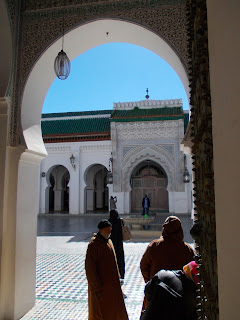Hello again from Morocco! I want to tell you about a fantastic trip I took to the city of Fez. Fez is one of three great imperial capitals of Morocco, along with Meknes and Marrakesh. The heart of Fez is a wonderful thousand-year-old walled old city (called a "medina" in Arabic). The city has lots of narrow walkways that twist and turn and wind about. If you don't know your way around, you can get lost really fast. I'll tell you more about the medina in my next post, but in this one I want to focus on the building at the heart of the city of Fez: Al-Karaouine University.
Al-Karaouine University is the oldest functioning university in the entire world. It was founded in AD 859 to provide an Islamic education to the people of Fez. 1,154 years later, it is still going strong. Let me put that date in perspective: this university is three centuries older than Oxford and eight centuries older than Harvard. Wow!
The university is part of a mosque, also called Al-Karaouine. The mosque is so big that it can fit 22,000 worshippers. For many centuries, it was the largest mosque on the continent of Africa. Unfortunately, I couldn't go inside. In Morocco, only Muslims are allowed to go inside mosques (this is not true of most other countries, where anybody can go inside a mosque when it is not time to pray). The best I can offer you is photos through the main gate of the central courtyard.
 |
| I pose in front of the gate to Al-Karaouine Mosque. |
 |
| Here is the courtyard of Al-Karaouine Mosque as seen through the gate. |
 |
| Would you like to do your homework in here? |
 |
| The sandal of the Prophet. |
Ibn Khaldun's ideas were very influential. One of the things he talked about was how dynasties rise and fall. He believed that nomads are very strong because they lead harsh lives in the desert and are thus bound together by "group feeling." At some point, these nomads succeed in conquering a city and setting up a dynasty. Once they live in a city, however, they begin to grow spoiled and corrupt and they lose their group feeling. Eventually, they are conquered by a new group of nomads. This cyclical theory of dynastic succession made Ibn Khaldun one of the first people to think about what we now call social science.
In this picture, I am standing in front of the first page of the handwritten version of The Muqaddimah. I got to see Ibn Khaldun's signature in his own hand! It was amazing!
 |
| I pose with Ibn Khaldun's signature! |
--Bobbe
No comments:
Post a Comment